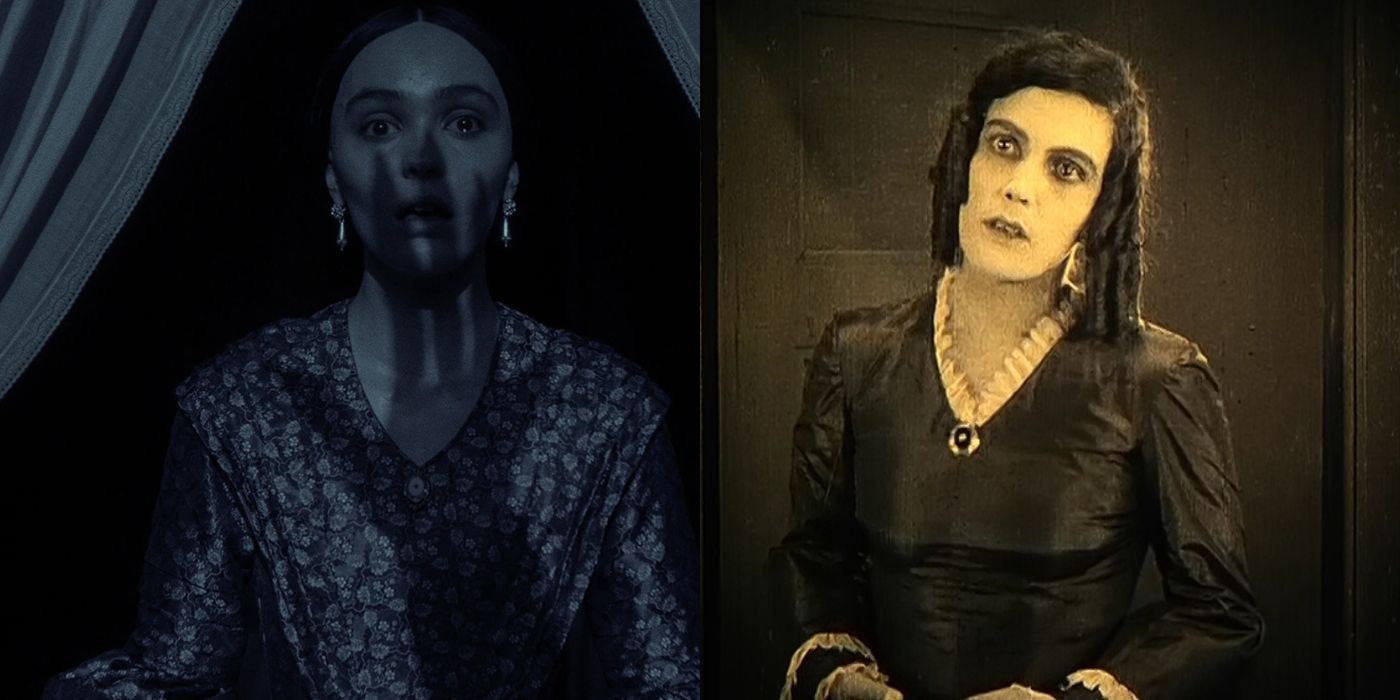The Long Legacy Preceding ‘Nosferatu’ (2024)
Robert Eggers is certainly no novice when it comes to directing horror films. Eggers instantly captured the audience's attention after bursting onto screens in 2015 with the folk-horror ‘The Witch’. Since then, he has refused to take his foot off the pedal. Fast forward four years to 2019, Eggers followed up his debut with ‘The Lighthouse' - this time set in the 19th century rather than the 17th-century setting of ‘The Witch’. Eggers proved to audiences that he could sustain a captivating filmography within the horror genre, with his sophomore flick being met largely with open arms and high-scoring reviews.

Anya Taylor-Joy as Thomasin in 'The Witch'
In 2022, Eggers continued his precedent of historically based films with his third feature-length picture, ‘The Northman’. This time, Eggers set his attention on the Vikings, specifically a Viking prince Amleth, played by Alexander Skarsgård. Alongside Skarsgård, the film features Nicole Kidman, Ethan Hawke, Björk, and returning Eggers alumni Anya Taylor-Joy and Willem Dafoe. With such a star-studded cast, it’s no surprise that ‘The Northman’grossed $5 million on its first day of release in the US and Canada.
So by the time trailers were released for his latest project, ‘Nosferatu’ (2024) Eggers had thoroughly established himself as a talented director. Anticipation for his next film was at an all-time high. It was released in the States on Christmas Day, and everywhere else on January 1st 2025. I have not yet had the pleasure of seeing it but you can bet I will be firmly seated in the cinema at some point this week. If you have already managed to catch Eggers most recent film I honestly only have one thing to say to you…

Nicholas Hoult and Aaron Taylor-Johnson in 'Nosferatu' 2024
Instead, I’ve been quelling my excitement with the original ‘Nosferatu.’ Released over one hundred years before its recent remake, the original is a German silent film released in 1922, directed by F. W. Murnau. The film tells the tale of Thomas Hutter, a resident of the fictional town Wisborg, sent to Transylvania by his boss, an estate agent. This business trip is intended to secure a deal with one of their clients, Count Orlok, who desires to buy a large derelict property opposite Hutter's own home. When his wife Ellen learns of Hutter's imminent departure, becomes grief-stricken. In her terrified state, Hutter entrusts her into the care of his friend Harding, and Harding’s sister Ruth.
Upon arriving in Transylvania, evidence emerges to suggest that this business trip will not proceed smoothly. Locals are frightened by the mere mention of Orlok’s name. The Count himself is an unusual fella, attempting to suck the blood from a minor wound Hutter receives. On his first morning in the Count’s castle, Hutter awakens to find puncture wounds on his neck… I’m sure anyone who has watched any vampire film can tell where this is going. The interesting thing about this particular vampire film is that it was the second one ever made (although ‘Nosferatu’ is widely considered to be the first, it was just pipped to the post by a Russian picture, ‘The Afterlife Wanderer’ from 1915).

Max Schreck as Count Orlok in 'Nosferatu' 1922
Anyone also familiar with vampire literature (or anyone who already knows the ‘Nosferatu’ lore) will recognise some striking similarities to another famous Count. That’s right, I’m talking about the big guy: Dracula. I would call him the true OG but that would be a lie.
Bram Stoker’s 1897 Gothic novel ‘Dracula’, while serving as the source material for the 1922 German adaptation (and most other vampire media) was not the first instance of a vampire within literary history. Sheridan Le Fanu’s 1872 novella ‘Carmilla’ predates Stoker’s story by over twenty years, and this text is predated by John Polidori’s short story ‘The Vampyre’, published in 1819. A fun fact about this text: it was composed following a writing competition between Polidori and his friends, Percy Shelley, Mary Shelley, and Lord Byron. This contest between these literary titans prompted Mary Shelley to pen her 1818 novel ‘Frankenstein’.
Returning to where we left off in the 1922 version of ‘Nosferatu’, Hutter has also begun to piece together the clues pointing towards Count Orlok’s true identity. The Count persists in his plans to move to Germany, while Hutter desperately races home with the realisation he has been aiding a vampire's relocation to his very own town. Orlok’s arrival in Wisborg is accompanied by the deaths of local residents, which doctors attribute to a plague. The film concludes with Ellen sacrificing herself to save the townsfolk, inviting Orlok into her room to distract him from the sunrise. The sun’s light causes Orlok to perish, but not before he has drained the selfless Ellen’s blood, resulting in her death.

Ellen in 'Nosferatu' 2024 on the left and Ellen in 'Nosferatu' 1922 on the right.
The original ‘Nosferatu’ is available to stream on Amazon Prime, and is well worth your time if you haven’t already seen it. It isn’t a particularly frightening vampire film but is an essential aspect of this subgenre’s history, with a very compelling narrative.
Since its release, there has been widespread acceptance of Bram Stoker’s ‘Dracula’ providing the initial inspiration for the film. The film itself acknowledges the novel as its source within its intertitles. Despite the clear connections, these two versions of the same story contain some striking differences. The most obvious being the setting of the narrative and the names of its characters. Stoker’s original text is located in Britain during its contemporary time period, the 1890s. ‘Nosferatu’ takes place in Germany in the 1830/40s.
The titular Count Dracula becomes Count Orlok - he is NOT called Nosferatu, a common misconception. The word itself was borrowed from Stoker’s original text. Some believe it to be derived from the Romanian word ‘Nesuferit’, meaning “insufferable” or “offensive”. Since its use in media and popular culture, the word nosferatu has become a synonym for the term vampire.
In the original ‘Dracula’ novel, the protagonist is called Jonathan Harker rather than Thomas Hutter; Harker has a finance name Mina rather than a wife called Ellen. Mina has a friend, Lucy, but in ‘Nosferatu’ Lucy does not exist. Rather the characteristics of Mina and Lucy are merged resulting in the formation of Ellen. Bram Stoker’s vampire hunter Van Helsing becomes Professor Bulwer in the 1922 ‘Nosferatu’ who then features in the 2024 remake as Professor Albin Eberhart.
Another area where ‘Nosferatu’ (1922) differs from Stoker’s source material is their respective Count’s reactions to sunlight. While sunlight does weaken Count Dracula it is not fatal for him to face exposure. A vampire perishing in sunlight was an addition first featured in the 1922 film, which has since been largely accepted as canon vampire lore.
However, all these changes to locations, character names and the fatality of its villain were not enough to save the 1922 silent film from a copyright claim made by Stoker’s relations. His widow Florence was the legal copyright holder after Bram passed. ‘Nosferatu’ cited this novel as its source material, yet Florence was never approached by anyone involved in the film’s production, and never received compensation for its use of her husband’s work. After a lengthy legal battle spanning several years, Florence’s claims were backed by the law. A settlement was reached wherein it was agreed that all copies of the film were to be destroyed. Evidently, this was an agreement law enforcement was unable to enforce as copies of the film evaded destruction. Thank goodness they did, or we may never have been graced with Egger’s latest release.
Hopefully, Egger’s version of this cult classic lives up to the hype. But, until I find the time to get to the cinema I’ll be desperately attempting to avoid any major spoilers for this version. In the meantime, I'll be rewatching the 1922 ‘Nosferatu’ and flipping through the pages of ‘Dracula' (and to be honest probably replaying ‘The Twilight Saga’ too, just for good measure).

